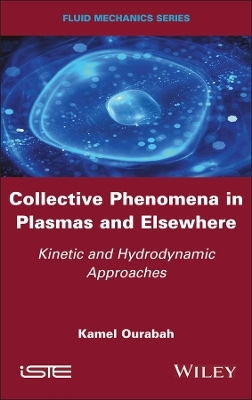
Collective Phenomena in Plasmas and Elsewhere
ISTE Ltd and John Wiley & Sons Inc (Verlag)
978-1-78630-769-9 (ISBN)
Collective Phenomena in Plasmas and Elsewhere presents an overview of the theoretical bases of these kinetic and hydrodynamic approaches, but also discusses their limitations, the links between them and their extension to quantum mechanics and relativity.
These methods were born in part out of the study of plasmas, but they also have more universal applications. A general framework for these approaches is outlined, followed by some applications in plasmas, gravitation, Bose–Einstein condensates and dark matter. Particular emphasis is placed on the analogies that can be made between all these different systems.
Kamel Ourabah is Associate Professor at the University of Science and Technology – Houari Boumediene, Algeria. His research interests focus on statistical physics and its applications in plasmas, gravitation and cosmology.
Preface ix
Introduction xi
Part 1 Theory 1
Chapter 1 Kinetic Theory 3
1.1 The impossibility of an accurate approach 4
1.2 Boltzmann equation 8
1.3 Collision term 11
1.3.1 Absence of collisions: Vlasov equation 11
1.3.2 Bhatnagar-Gross-Krook relaxation model 12
1.3.3 Boltzmann collision integral 13
1.3.4 Fokker-Planck collision term 16
1.4 Steady state: Boltzmann distribution 18
1.5 Maxwell-Boltzmann distribution: properties 24
1.6 H-theorem 32
1.7 Paradoxes related to H-theorem 35
1.7.1 Loschmidt’s paradox of irreversibility 35
1.7.2 Zermelo paradox 36
Chapter 2 Hydrodynamic Approach 37
2.1 Fluid model: a heuristic approach 38
2.2 Macroscopic transport equation 39
2.3 Fluid model 41
2.4 Pressure tensor 44
2.4.1 Isotropic pressure 45
2.4.2 Anisotropic pressure 45
2.5 A deadlock in the fluid model: closure relationships 46
2.5.1 Zero pressure 46
2.5.2 Isothermal pressure 47
2.6 The collision effect 48
Chapter 3 Quantum Models 51
3.1 Physical interest 52
3.2 Quantum hydrodynamic model 54
3.3 Quantum kinetic approach: Wigner-Moyal theory 58
3.3.1 Wigner distribution 58
3.3.2 Weyl transformation 62
3.3.3 Evolution of the Wigner distribution 64
Chapter 4 General Relativity 67
4.1 Relativistic hydrodynamics 68
4.1.1 Conservation equations 68
4.1.2 Hydrodynamics in special relativity 69
4.1.3 Hydrodynamic model in general relativity 71
4.2 Relativistic kinetic theory 72
4.2.1 Basic concepts 72
4.2.2 Formulation of kinetic theory 75
4.2.3 Collision integral 77
4.2.4 Boltzmann equation in general relativity 79
4.2.5 H-theorem 81
4.2.6 Equilibrium state: Juttner distribution 82
Part 2 Applications 87
Chapter 5 Plasmas 89
5.1 Electronic oscillations in classical plasmas: a hydrodynamic approach 91
5.2 Ion waves: hydrodynamic approach 95
5.3 Classic plasmas: kinetic approach 97
5.4 Quantification of electronic oscillations: hydrodynamic and kinetic approaches 103
5.5 In a relativistic plasma: kinetic approach 105
5.6 Beyond the linear approach: the Korteweg-De Vries equation 110
Chapter 6 Gravitational Systems 115
6.1 Jeans instability: hydrodynamic approach 116
6.2 Kinetic approach and collision effect 120
6.3 Jeans instability in the presence of dark matter 123
6.3.1 Kinetic approach 124
6.3.2 Hydrodynamic approach 128
6.4 Jeans instability: alternative theories 130
Chapter 7 Bose-Einstein Condensates 135
7.1 Quantum hydrodynamic representation 137
7.2 Quantum kinetic representation 139
7.3 Kinetic approach to Bogoliubov oscillations 141
Chapter 8 Cosmology and Dark Matter Models 145
8.1 Hydrodynamics of the Universe 145
8.1.1 Perturbation in a static Universe 149
8.1.2 Perturbations in an expanding Universe 151
8.2 Dark matter models 153
8.2.1 Hydrodynamic representation 155
8.2.2 Kinetic representation 157
Appendix Language of Relativity 159
References 165
Index 169
| Erscheinungsdatum | 19.09.2023 |
|---|---|
| Verlagsort | London |
| Sprache | englisch |
| Gewicht | 553 g |
| Themenwelt | Technik ► Maschinenbau |
| ISBN-10 | 1-78630-769-3 / 1786307693 |
| ISBN-13 | 978-1-78630-769-9 / 9781786307699 |
| Zustand | Neuware |
| Haben Sie eine Frage zum Produkt? |
aus dem Bereich


